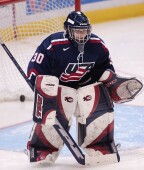
SUNDAY, Sept. 26 (HealthDay News) — Emergency department visits for ice hockey-related injuries among U.S. children aged 9 to 14 soared from 2,935 in 1990 to 7,713 in 2006 — an increase of 163 percent, researchers have found.
Meanwhile, during that same time period, the number of injuries among teens aged 15 to 18 jumped 85 percent, according to the study published in the September/October issue of the Journal of Athletic Training.
The dramatic climb in injuries highlights the need for a greater emphasis on safety, said the researchers at Ohio State University and the Center for Injury Research and Policy at Nationwide Children’s Hospital in Columbus.
The study authors were startled to find, for example, that nearly one in four of the injuries was to the face or mouth — injuries that are preventable, they said, if young players wear face masks and shields at all times, even during non-contact drills.
“The incidence of ice hockey injuries will likely continue to increase, given the sport’s growing popularity, unless we make a concerted effort to make sure kids wear the proper protective equipment,” study lead author Jeff Deits said in a university news release.
In addition, concussions accounted for nearly one in 10 injuries reported in youngsters under age 18, a finding that prompted the study authors to suggest limits on body-checking among younger players. Although body-checking is often allowed in kids as young as 11, the American Academy of Pediatrics recommends the practice be banned in youngsters under the age of 15.
Deits and colleagues also found that hockey injuries among girls and women rose 347 percent during the study period, and that females made up an increasingly larger proportion of hockey injuries, accounting for 4.8 percent of injuries from 1990 to 1999 and 8.9 percent from 2000 to 2006.
“Women are about as likely to be injured playing hockey as men, and their participation has increased greatly, which explains why women’s injuries have increased so much,” Deits said.
For the study, the researchers analyzed data from the National Electronic Injury Surveillance System, which collects injury reports from 100 U.S. hospitals. While the number of injuries among children, teens and females has skyrocketed, there wasn’t a significant increase in the overall number of hockey injuries in the United States.
Deits, who conducted the study while at Ohio State University’s School of Physical Activity and Educational Services, is now an assistant athletic trainer at Wichita State University.
More information
The American Academy of Orthopaedic Surgeons offers hockey injury prevention tips.

